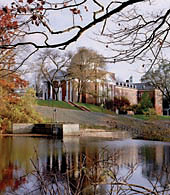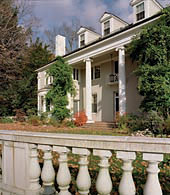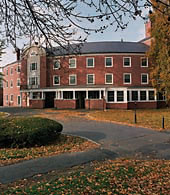 |
Campus
Guide Captures Smith Architecture
Photographs
from The Campus Guide: Smith College:

Sage Hall from Paradise Pond
|

President's House |

Laura Scales House, Elm St. |
There’s College Hall, Smith’s first building,
constructed in 1875, a dramatic red-brick structure capped
by a towering clock tower. There’s the columned John
M. Greene Hall, inspired by Roman and Renaissance monuments.
There are buildings whose constructions predate the opening
of the college, such as Sessions House, built around 1750
in classic Georgian style; and Capen and Dewey, which were
built around 1825 in the popular Greek revival style.
The range of architectural achievements at Smith is captured
in a new book, The Campus Guide: Smith College,
a lustrous volume filled with colorful, glossy photographs
of the Smith campus.
The guide, which
is available through Amazon.com and soon at Grécourt Bookshop, is organized into five “walks” among
67 campus buildings, each illustrated and discussed architecturally
and in historical college context. Walk One tours the corner
of campus around College Hall, including Neilson Library,
Wright and Hatfield halls, and the Brown Fine Arts Center.
The walks proceed through campus, exploring the architecture
of other notable buildings, such as Sage Hall, Burton Hall,
the president’s house, Lyman Conservatory, Helen Hills
Hills Chapel, and many others.
The guide features
a foreword by President Carol T. Christ; an essay, “An Academic Landscape,” by
Nina Antonetti, assistant professor of landscape studies;
text written by local architectural historian Margaret
Birney Vickery; and photographs by Bilyana Dimitrova, an
architectural photographer and photo editor for Metropolis magazine.
“No single style or aesthetic dominates Smith’s
architecture; its houses and halls are united in their diversity
and eclecticism, animated by a commitment to design that
is right for its time and resilient to the test of time,” writes
President Christ in the book’s introduction. “The
campus’s compact footprint—125 contiguous acres—affords
the visitor an experience of a remarkable variety of architectural
traditions on even the shortest walk.”
As noted in the
book, a tour of Smith’s 100-plus buildings
is like a literal review of architectural history for more
than 150 years. The Campus Guide: Smith College seeks
to capture the history of Smith’s aesthetic evolution
in pictures and prose.
The Campus Guide: Smith College is one in a series
of books that illustrate the architecture on notable American
campuses, including Duke, Harvard, Princeton, Stanford and
Yale universities, and Vassar College. It was published this
year by Princeton Architectural Press.
|
 |























